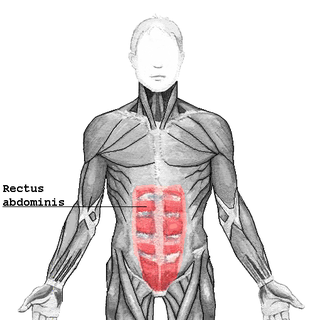Top Qs
Timeline
Chat
Perspective
Rectus sheath
Laminas around abdominal muscles From Wikipedia, the free encyclopedia
Remove ads
The rectus sheath (also called the rectus fascia[1]) is a tough fibrous compartment formed by the aponeuroses of the transverse abdominal muscle, and the internal and external oblique muscles. It contains the rectus abdominis and pyramidalis muscles, as well as vessels and nerves.[2]
Remove ads
Structure
Summarize
Perspective
The rectus sheath extends between the inferior costal margin and costal cartilages of ribs 5-7 superiorly, and the pubic crest inferiorly.[2]
Studies indicate that all three aponeuroses constituting the rectus sheath are in fact bilaminar.[3]
Below the costal margin
Superficial/anterior to the anterior layer of the rectus sheath are the following two layers:[4]
- Camper's fascia (anterior part of superficial fascia)
- Scarpa's fascia (posterior part of the superficial fascia)
Deep/posterior posterior layer of the rectus sheath (where present) are the following three layers:[citation needed]
Above the costal margin
Since the tendons of the internal oblique and transversus abdominis only reach as high as the costal margin, it follows that above this level the sheath of the rectus is deficient behind, the muscle resting directly on the cartilages of the ribs, and being covered only by the tendons of the external obliques.[citation needed]
Remove ads
Clinical significance
The rectus sheath is a useful attachment for surgical meshes during abdominal surgery.[6] This has a higher risk of infection than many other attachment sites.[6]
Additional images
- The Cremaster
- The interfoveolar ligament, seen from in front.
References
External links
Wikiwand - on
Seamless Wikipedia browsing. On steroids.
Remove ads





